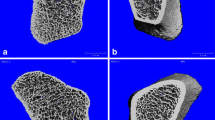Abstract.
It has been recognized that celiac disease (CD) may be associated with osteoporosis. However, few data exist regarding bone disorders in adult patients with subclinical CD (SCD) and the best densitometric technique for assessing bone mineral density (BMD). We compared dual X-ray absorptiometry (DXA) and quantitative computed tomography (QCT) in measuring the lumbar spine of 23 female patients with SCD and 19 healthy subjects. There were lower densitometric values in the subjects with SCD than the control group. We found discordance between DXA and QCT results using World Health Organization (WHO) criteria with the T score. With QCT as the reference method for its sensitivity, we found one false-negative, two false-positive and two misdiagnosed cases. We suggest some correction factors to improve DXA evaluation and screening of bone loss in CD.
Similar content being viewed by others
Author information
Authors and Affiliations
Corresponding author
Rights and permissions
About this article
Cite this article
Masala, S., Annibale, B., Fiori, R. et al. DXA vs. QCT for subclinical celiac disease patients. Acta Diabetol 40 (Suppl 1), s174–s176 (2003). https://doi.org/10.1007/s00592-003-0058-2
Issue Date:
DOI: https://doi.org/10.1007/s00592-003-0058-2




